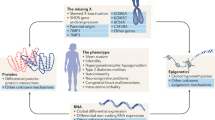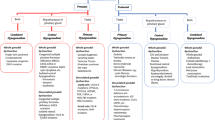Abstract
Aromatase deficiency is rare in humans. Affected individuals cannot synthesize endogenous estrogens. Aromatase is the enzyme that catalyzes conversion of androgens into estrogens, and if aromatase is nonfunctional because of an inactivating mutation, estrogen synthesis cannot occur. If the fetus lacks aromatase activity, dehydroepiandrosterone sulfate produced by the fetal adrenal glands cannot be converted to estrogen by the placenta, so is converted to testosterone peripherally and results in virilization of both fetus and mother. Virilization manifests as pseudohermaphroditism in female infants, with hirsutism and acne in the mother; the maternal indicators resolve following delivery. To date, only seven males and seven females with aromatase deficiency have been reported. Affected females are typically diagnosed at birth because of the pseudohermaphroditism. Cystic ovaries and delayed bone maturation can occur during childhood and adolescence in these girls, who present at puberty with primary amenorrhea, failure of breast development, virilization, and hypergonadotrophic hypogonadism. Affected males, on the other hand, do not present with obvious defects at birth, so are diagnosed much later in life, presenting with clinical symptoms, which include tall stature, delayed skeletal maturation, delayed epiphyseal closure, bone pain, eunuchoid body proportions and excess adiposity. Estrogen replacement therapy reverses the symptoms in male and female patients.
Key Points
-
Aromatase deficiency is rare
-
Aromatase deficiency should be suspected in any pregnancy in which the mother becomes virilized
-
This condition should be suspected when a female newborn presents with ambiguous genitalia
-
When an adult male presents with tall stature, delayed skeletal maturation, delayed epiphyseal closure, eunuchoid body proportions, and undetectable estrogens concomitant with elevated levels of testosterone, aromatase deficiency should be suspected
This is a preview of subscription content, access via your institution
Access options
Subscribe to this journal
Receive 12 print issues and online access
$209.00 per year
only $17.42 per issue
Buy this article
- Purchase on Springer Link
- Instant access to full article PDF
Prices may be subject to local taxes which are calculated during checkout

Similar content being viewed by others
References
Simpson ER et al. (1997) Aromatase expression in health and disease. Recent Prog Horm Res 52: 185–213
Simpson ER et al. (1987) Sequencing of cDNA inserts encoding aromatase cytochrome P-450 (P-450AROM). Mol Cell Endocrinol 52: 267–272
Bulun SE (2004) et al. Organization of the human aromatase p450 (CYP19) gene. Semin Reprod Med 22: 5–9
Simpson E et al. (2000) The role of local estrogen biosynthesis in males and females. Trends Endocrinol Metab 11: 184–188
Mahendroo MS et al. (1993) Tissue-specific and hormonally controlled alternative promoters regulate aromatase cytochrome P450 gene expression in human adipose tissue. J Biol Chem 268: 19463–19470
Jones ME et al. (2006) Of mice and men: the evolving phenotype of aromatase deficiency. Trends Endocrinol Metab 17: 55–64
Bouillon R et al. (2004) Estrogens are essential for male pubertal periosteal bone expansion. J Clin Endocrinol Metab 89: 6025–6029
Carani C et al. (1997) Effect of testosterone and estradiol in a man with aromatase deficiency. N Engl J Med 337: 91–95
Deladoey J et al. (1999) Aromatase deficiency caused by a novel P450arom gene mutation: impact of absent estrogen production on serum gonadotropin concentration in a boy. J Clin Endocrinol Metab 84: 4050–4054
Herrmann BL et al. (2002) Impact of estrogen replacement therapy in a male with congenital aromatase deficiency caused by a novel mutation in the CYP19 gene. J Clin Endocrinol Metab 87: 5476–5484
Maffei L et al. (2004) Dysmetabolic syndrome in a man with a novel mutation of the aromatase gene: effects of testosterone, alendronate, and estradiol treatment. J Clin Endocrinol Metab 89: 61–70
Morishima A et al. (1995) Aromatase deficiency in male and female siblings caused by a novel mutation and the physiological role of estrogens. J Clin Endocrinol Metab 80: 3689–3698
Pura MM et al. (2003) Clinical findings in an adult man with a novel mutation in the aromatase gene [abstract]. In The 85th Annual Meeting of The Endocrine Society: 2003 June 19–22; Philadelphia, 1–467
Belgorosky A et al. (2003) Hypothalamic-pituitary-ovarian axis during infancy, early and late prepuberty in an aromatase-deficient girl who is a compound heterocygote for two new point mutations of the CYP19 gene. J Clin Endocrinol Metab 88: 5127–5131
Conte FA et al. (1994) A syndrome of female pseudohermaphrodism, hypergonadotropic hypogonadism, and multicystic ovaries associated with missense mutations in the gene encoding aromatase (P450arom). J Clin Endocrinol Metab 78: 1287–1292
Ludwig M et al. (1998) Female pseudohermaphroditism associated with a novel homozygous G-to-A (V370-to-M) substitution in the P-450 aromatase gene. J Pediatr Endocrinol Metab 11: 657–664
Mullis PE et al. (1997) Aromatase deficiency in a female who is compound heterozygote for two new point mutations in the P450arom gene: impact of estrogens on hypergonadotropic hypogonadism, multicystic ovaries, and bone densitometry in childhood. J Clin Endocrinol Metab 82: 1739–1745
Portrat-Doyen S et al. (1996) Female pseudohermaphroditism (FPH) resulting from aromatase (P450arom) deficiency associated with a novel mutation (R457X) in the CYP19 gene [abstract]. Horm Res 46 (Suppl 2): S14
Shozu M et al. (1991) A new cause of female pseudohermaphroditism: placental aromatase deficiency. J Clin Endocrinol Metab 72: 560–566
Chen S and Zhou D (1992) Functional domains of aromatase cytochrome P450 inferred from comparative analyses of amino acid sequences and substantiated by site-directed mutagenesis experiments. J Biol Chem 267: 22587–22594
Bulun SE (1996) Clinical review 78: aromatase deficiency in women and men: would you have predicted the phenotypes? J Clin Endocrinol Metab 81: 867–871
Simpson ER (2004) Models of aromatase insufficiency. Semin Reprod Med 22: 25–30
Smith EP et al. (1994) Estrogen resistance caused by a mutation in the estrogen-receptor gene in a man. N Engl J Med 331: 1056–1061
Oettel M (2002) Is there a role for estrogens in the maintenance of men's health? Aging Male 5: 248–257
Gennari L et al. (2004) Aromatase activity and bone homeostasis in men. J Clin Endocrinol Metab 89: 5898–5907
Khosla S et al. (2002) Clinical review 144: estrogen and the male skeleton. J Clin Endocrinol Metab 87: 1443–1450
Bilezikian JP et al. (1998) Increased bone mass as a result of estrogen therapy in a man with aromatase deficiency. N Engl J Med 339: 599–603
Herrmann BL et al. (2005) Effects of estrogen replacement therapy on bone and glucose metabolism in a male with congenital aromatase deficiency. Horm Metab Res 37: 178–183
Riggs BL et al. (2002) Sex steroids and the construction and conservation of the adult skeleton. Endocr Rev 23: 279–302
Rochira V et al. (2002) Congenital estrogen deficiency in men: a new syndrome with different phenotypes; clinical and therapeutic implications in men. Mol Cell Endocrinol 193: 19–28
Faustini-Fustini M et al. (1999) Oestrogen deficiency in men: where are we today? Eur J Endocrinol 140: 111–129
Grumbach MM and Auchus RJ (1999) Estrogen: consequences and implications of human mutations in synthesis and action. J Clin Endocrinol Metab 84: 4677–4694
Mittre Herve MH et al. (2004) Human gene mutations. Gene symbol: CYP19. Disease: aromatase deficiency. Hum Genet 114: 224
Baumgartner RN et al. (1995) Human body composition and the epidemiology of chronic disease. Obes Res 3: 73–95
Horber FF et al. (1997) Effect of sex and age on bone mass, body composition and fuel metabolism in humans. Nutrition 13: 524–534
Isidori AM et al. (2005) Effects of testosterone on sexual function in men: results of a meta-analysis. Clin Endocrinol (Oxf) 63: 381–394
Reaven GM (2005) Why Syndrome X? From Harold Himsworth to the insulin resistance syndrome. Cell Metab 1: 9–14
Expert Panel on Detection, Evaluation, and Treatment of High Blood Cholesterol in Adults (2001) The National Cholesterol Education Program (NCEP) Expert Panel on Detection, Evaluation, and Treatment of High Blood Cholesterol in Adults (Adult Treatment Panel III). JAMA 285: 2486–2497
Prabhakaran D and Anand SS (2004) The metabolic syndrome: an emerging risk state for cardiovascular disease. Vasc Med 9: 55–68
Carani C et al. (2005) Sex steroids and sexual desire in a man with a novel mutation of aromatase gene and hypogonadism. Psychoneuroendocrinology 30: 413–417
Carani C et al. (1999) Role of oestrogen in male sexual behaviour: insights from the natural model of aromatase deficiency. Clin Endocrinol (Oxf) 51: 517–524
Harada N et al. (1992) Biochemical and molecular genetic analyses on placental aromatase (P-450AROM) deficiency. J Biol Chem 267: 4781–4785
Ito Y et al. (1993) Molecular basis of aromatase deficiency in an adult female with sexual infantilism and polycystic ovaries. Proc Natl Acad Sci USA 90: 11673–11677
World health Organization (1999) WHO Laboratory Manual for the Examination of Human Semen and Sperm-Cervical Mucus Interaction. Cambridge, UK: Cambridge University Press
Esoterix Inc. Laboratory Services. Expected Values and S.I. Unit Conversion Pocket Book [http://www.esoterix.com/files/expected_values.pdf] (accessed 15 February 2006)
Acknowledgements
This work was supported by US Public Health Service Grant R37-AG08174, National Health and Medical Research Council (NHMRC) Project Grants 169010 and 338510, and NHMRC Fellowship Award 241024 to MEE Jones. Written consent for publication of the photograph used in Figure 1 was obtained from the patient and clinician involved.
Author information
Authors and Affiliations
Corresponding author
Ethics declarations
Competing interests
The authors declare no competing financial interests.
Rights and permissions
About this article
Cite this article
Jones, M., Boon, W., McInnes, K. et al. Recognizing rare disorders: aromatase deficiency. Nat Rev Endocrinol 3, 414–421 (2007). https://doi.org/10.1038/ncpendmet0477
Received:
Accepted:
Issue Date:
DOI: https://doi.org/10.1038/ncpendmet0477
This article is cited by
-
Applying the adverse outcome pathway concept for assessing non-monotonic dose responses: biphasic effect of bis(2-ethylhexyl) phthalate (DEHP) on testosterone levels
Archives of Toxicology (2023)
-
The evolving role of genetic tests in reproductive medicine
Journal of Translational Medicine (2019)



